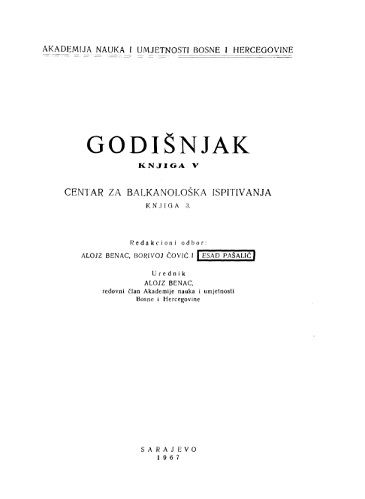Ilirsko pleme Delmati
The Illyrian Tribe of the Delmatae
Author(s): Marin ZaninovićSubject(s): Cultural history, Ethnohistory, Social history, Ancient World, Social development
Published by: Akademija Nauka i Umjetnosti Bosne i Hercegovine
Keywords: The Illyrian Tribe; Delmatae; Dalmatia; social history;
Summary/Abstract: This part o f the paper deals with some aspects of the Delmatian civilization and the romanization of their area. Material remains o f the human groups are usually best preserved in their settlements, i.e. when there are still some remains of these. The Delmatae, like many other Illyrian, tribes, have generally lived in fortified settlements. Many of these sites are still visible, and bear as a rule the well-known in the toponymy of this country, term grad i n a (hill-fort), which people gave to such prehistoric, but sometimes to medieval ruins also. Systematic exploration o f these sites is still in the beginning. These places are usually lost in mountainous areas. The difficulty is in the absence of archaeological strata, especially in the rocky area of the Delmatae, where the atmospheric conditions through centuries have washed away nearly all soil to the barren stone. Very often, only some sherds of pottery, or a wall deteriorated to simple stone barrow mark such a monument. But it is possible to give some general characteristics of these sites. As a rule, they are placed around their fertile valleys o f the present Dinaric Mountains area. Never on the highest or lowest peaks surrounding the valley, but usually on the medium-height hills over these valleys. These hills are joined with one part to the main mountain range. This part is usually one o f the weakest points o f the system and consequently the most fortified. Other sides are steep or deep ravines. The positions o f the hill-forts are chosen to control a wide area, so the views from these sites are always splendid. In a great number of these hill-forts there are many which played an important part in the battles and the resistance of the Delmatae to the Romans. Some are known to us from other sources such as inscriptions, itineraries etc. The author tries to identify some of them with one of the ancient names: Andetrium, Bariduum, Burnum, Erona, Synodium, Ninia, Osmium, Salvia, Soetovia, Tilurium, Nerate, Pituntium; or analyzes the positions of identified localities, such as Delminium, Promona, Rider, Oneum, In the Roman period, the settlements are transferred and continue to develop below their hill-fort predecessors on the fringes o f the valleys. Some of the hill-forts were completely destroyed or resettled by Romans and never again restored. But in some cases, their life continued in the historical period simultaneously in the new-founded settlements in the valleys and in those on the hill; and went so unbroken to the end of Antiquity. Below these settlements, a Roman communications system developed which in main lines was overlaid on the old prehistoric trade routes. So, these hill-fort settlements are the most important sites for the Delmatae, because the key events o f their liistory happened in or around them (Delminium, Andetrium, Promona, Soetovia). They form the link between the prehistoric, protohistoric and historical periods o f their history, and so the importance o f their exploration, although they are so poor in the finds and denudatecl, cannot be sufficiently stressed. In the area of the Delmatae, so far no necropole has been found or explored of a size or importance like those in the areas of some other Illyrian tribes, e.g. the Iapodi (Prozor, Jezerine), the Daesitiates (Glasinac), the Liburni (Nin). Many stone barrows are scaterred over the Dalmatian area, although not in a number which could be expected. In the Roman period, with simple inhumation the Delmatae used the stone urn as a sepulchral monument. These urns are found in all parts of their territory. From their number we can deduce that they enjoyed popularity with the autochthonous population, as is also attested by the Delmatian Illyrian names written on them (Beusas, Dasas, Seio, Suttis, Bato etc.). Decorative elements seen on the urns are combined floral and architectural motives, some of them taken from the Greek and Roman sepulchral repertory. The genesis of these urns is to be seen in the stone barrows, i.e. in the stone-slab caskets found inside. In the Roman period, only this stone box was left, but then transformed in the monolith urn. In any case, these urns found from Glamoč to Rider, are another strong evidence — with their decorations, form and onomastics — of the ritual — sepulchral unity of the Delmatae from both sides of the Dinara mountain.
Journal: Godišnjak Centra za balkanološka ispitivanja
- Issue Year: 1967
- Issue No: 5
- Page Range: 5-101
- Page Count: 97
- Language: Serbian

